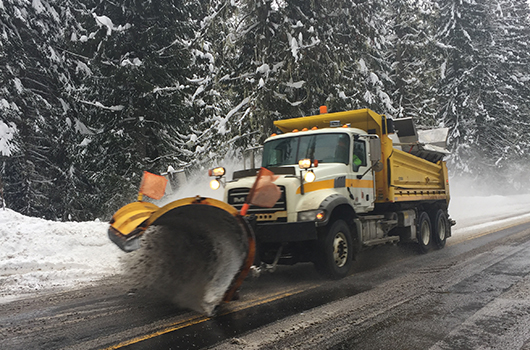Snow has already fallen in the state, so drivers should get ready to drive with plows this winter. Talking about sharing the road with plows is really more of a discussion on what you shouldn’t do.
What shouldn’t you do?
Don’t pass. The road behind a plow is always better than the road in front of a plow. And all the snow, rock and other debris comes out of a plow at a high rate of speed––if you pass and try to drive through all that, the weight of the snow could force your vehicle off the road or break windows.
Of course, that’s assuming you don’t run into the plow while attempting to pass it.
Plows trucks weigh up to 58,000 pounds and sport not one, but two, plows. Everyone is familiar with the plow on the front, which is 12 feet long and takes up a whole lane. People tend to forget about the second, smaller plow positioned on the right side of the truck. It’s called a wing plow.
That’s the one folks run into. When plows are pushing snow, it comes up over the top of the plow and obscures all the lighting and flags. Again, plows weigh up to 14 times the average vehicle, so running into them is going to have an impact.
While not illegal to pass a plow, it’s recommended you never do so on the right side because of the wing plow. Law enforcement can and will cite drivers who act recklessly or carelessly and pass when it isn’t safe.
Operators will often work in pairs, especially on multi-lane roadways like freeways, to get snow pulled from the far left side all the way to the shoulder. Don’t try to pass several plows at once or drive between them.
Plows are large vehicles with blind spots, even when not working in blizzard conditions or pushing snow. Stay out of their blind spots.
If you’re going to pass, it’s important to consider where the snow is going. Our drivers typically push snow to the right, but in some cases, they will push snow into the median.
Sometimes there isn’t room to push snow into the median, or there aren’t enough operators available to tandem plow. You may see a plow working by itself on a freeway, pushing snow into the fast lane on the first lap and then moving it all the way off the roadway on a second pass. There may be enough room to pass safely on the right – but first slow down and observe where the snow coming out of the plow lands on the road before you make your decision.
When in doubt, don’t pass.
What should you do?
- Drive for conditions. The posted speed limit is set based on ideal conditions, so in winter you’ll have to slow down. It’s on the driver to determine a safe speed.
- Maintain at least a three-second following distance. On slick roads, you’ll need more time to react and stop if necessary.
- Move over. Any time emergency vehicles—which include tow trucks—are flashing their lights, you are legally required to slow down and move over into another lane if possible.
- Leave early. Giving yourself extra time will make it that much easier to make smart decisions.
- Download 511. No need to guess what your route looks like – download the 511 app or visit 511.idaho.gov to see road conditions and if there are any reported crashes.
As you head out on the road this winter, keep these safety tips in mind so that you and our plow drivers can make it home safely.

